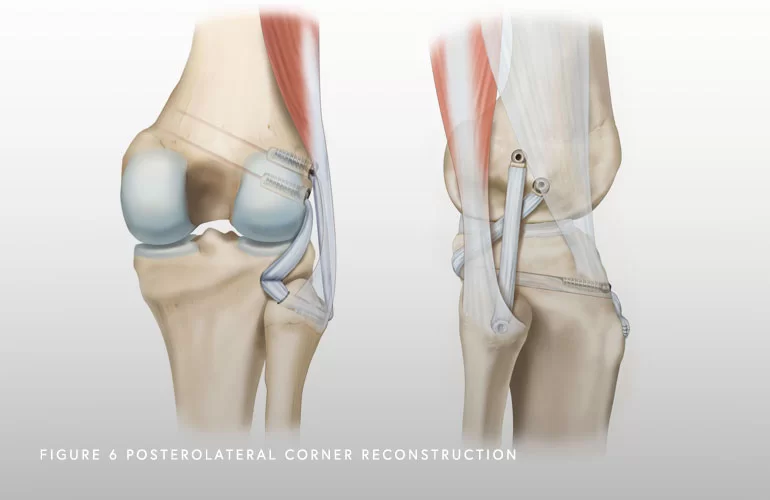Posterolateral Corner (PLC) Injuries Treatment Options
Can a PLC injury be treated without surgery?
Most of the time injuries to the PLC do not heal on their own because the thighbone and the shinbone (lateral femoral condyle of the femur and lateral tibial plateau of the tibia) are both convex (round) which makes this part of the knee inherently unstable if the ligaments and tendons are damaged. Thus, these injuries should be seen and treated quickly to achieve the best outcomes. Additionally, almost all complete PLC injuries occur with injuries to other knee ligaments (almost 80%). When additional ligaments are involved, surgical reconstruction is required to restore the anatomy.
What are the surgical options for an PLC injury?
Dr. Jorge Chahla helped to establish a global consensus on the treatment of PLC injuries. Surgeons from around the world agreed that Grade 1 and 2 tears can be treated nonoperatively with physical therapy, while Grade 3 tears should almost always be treated with surgery.
When there is a complete tear of the LCL, or when all the structures of the posterolateral corner of the knee are injured, surgery should be pursued within the first two weeks after injury, and once range of motion has been recovered. This is the best time to repair the structures, before there is significant scar formation, or the tissues become weakened. The position and alignment of the knee can also be anatomically restored during that time frame, rather than delaying and allowing the knee to heal in an abnormal position.
Recent reconstruction techniques have allowed many patients to get back to high-level activities. This was not true in the past when a PLC injury would typically end further sports participation or even limit participation in normal activities because of ongoing knee problems.
Restoring the native anatomy of the posterolateral corner can allow for early postoperative range of motion and produce better outcomes. Using grafts, Dr. Chahla performs a technique that reconstructs the injured ligaments to restore all the native insertions of the posterolateral corner. These grafts are typically allografts (from a donor) and are fixated using non-metal screws.
If you wait six weeks or longer to be treated and you are bowlegged (most men are slightly bow-legged), an osteotomy, or a surgical correction of the bow leggedness, may be needed before proceeding with the ligament reconstruction, to make sure that the surgically reconstructed ligaments do not stretch out due to persistent varus stress on the knee.

Treatment for PLC injuries varies based on severity. Non-surgical options such as bracing and physical therapy may be effective for mild cases, while surgical reconstruction may be necessary for severe injuries. Dr. Jorge Chahla provides customized PLC injury treatments, ensuring patients receive the best approach for long-term knee stability. If you have a PLC injury, schedule an appointment with Dr. Chahla in Chicago, Naperville, or Oak Brook to explore your treatment options.
At a Glance
Dr. Jorge Chahla
- Triple fellowship-trained sports medicine surgeon
- Performs over 700 surgeries per year
- Associate professor of orthopedic surgery at Rush University
- Learn more
